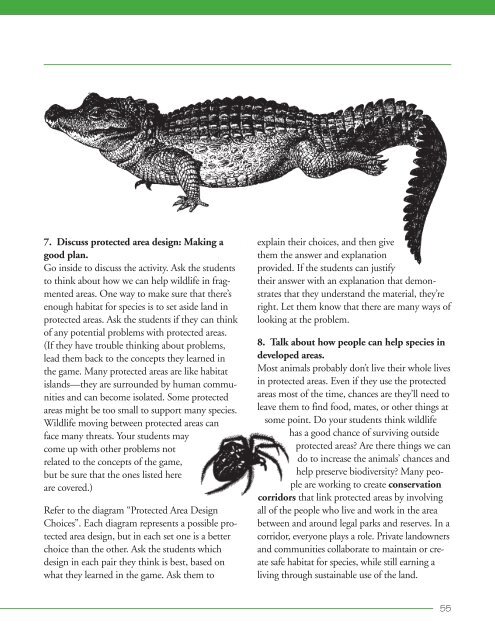EXPLORING BIODIVERSITY: A Guide for Educators Around the World
EXPLORING BIODIVERSITY: A Guide for Educators Around the World
EXPLORING BIODIVERSITY: A Guide for Educators Around the World
You also want an ePaper? Increase the reach of your titles
YUMPU automatically turns print PDFs into web optimized ePapers that Google loves.
7. Discuss protected area design: Making a<br />
good plan.<br />
Go inside to discuss <strong>the</strong> activity. Ask <strong>the</strong> students<br />
to think about how we can help wildlife in fragmented<br />
areas. One way to make sure that <strong>the</strong>re’s<br />
enough habitat <strong>for</strong> species is to set aside land in<br />
protected areas. Ask <strong>the</strong> students if <strong>the</strong>y can think<br />
of any potential problems with protected areas.<br />
(If <strong>the</strong>y have trouble thinking about problems,<br />
lead <strong>the</strong>m back to <strong>the</strong> concepts <strong>the</strong>y learned in<br />
<strong>the</strong> game. Many protected areas are like habitat<br />
islands—<strong>the</strong>y are surrounded by human communities<br />
and can become isolated. Some protected<br />
areas might be too small to support many species.<br />
Wildlife moving between protected areas can<br />
face many threats. Your students may<br />
come up with o<strong>the</strong>r problems not<br />
related to <strong>the</strong> concepts of <strong>the</strong> game,<br />
but be sure that <strong>the</strong> ones listed here<br />
are covered.)<br />
Refer to <strong>the</strong> diagram “Protected Area Design<br />
Choices”. Each diagram represents a possible protected<br />
area design, but in each set one is a better<br />
choice than <strong>the</strong> o<strong>the</strong>r. Ask <strong>the</strong> students which<br />
design in each pair <strong>the</strong>y think is best, based on<br />
what <strong>the</strong>y learned in <strong>the</strong> game. Ask <strong>the</strong>m to<br />
explain <strong>the</strong>ir choices, and <strong>the</strong>n give<br />
<strong>the</strong>m <strong>the</strong> answer and explanation<br />
provided. If <strong>the</strong> students can justify<br />
<strong>the</strong>ir answer with an explanation that demonstrates<br />
that <strong>the</strong>y understand <strong>the</strong> material, <strong>the</strong>y’re<br />
right. Let <strong>the</strong>m know that <strong>the</strong>re are many ways of<br />
looking at <strong>the</strong> problem.<br />
8. Talk about how people can help species in<br />
developed areas.<br />
Most animals probably don’t live <strong>the</strong>ir whole lives<br />
in protected areas. Even if <strong>the</strong>y use <strong>the</strong> protected<br />
areas most of <strong>the</strong> time, chances are <strong>the</strong>y’ll need to<br />
leave <strong>the</strong>m to find food, mates, or o<strong>the</strong>r things at<br />
some point. Do your students think wildlife<br />
has a good chance of surviving outside<br />
protected areas? Are <strong>the</strong>re things we can<br />
do to increase <strong>the</strong> animals’ chances and<br />
help preserve biodiversity? Many people<br />
are working to create conservation<br />
corridors that link protected areas by involving<br />
all of <strong>the</strong> people who live and work in <strong>the</strong> area<br />
between and around legal parks and reserves. In a<br />
corridor, everyone plays a role. Private landowners<br />
and communities collaborate to maintain or create<br />
safe habitat <strong>for</strong> species, while still earning a<br />
living through sustainable use of <strong>the</strong> land.<br />
55

















